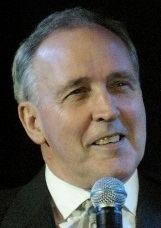13 March 1993 (1993-03-13) 1996 → 80 seats 65 seats 5,436,421 5,133,033 | 78 seats 69 seats 2 4 | |
 | ||
19 December 1991 (1991-12-19) 3 April 1990 (1990-04-03) | ||
Federal elections were held in Australia on 13 March 1993. All 147 seats in the House of Representatives, and 40 seats in the 76-member Senate, were up for election. The incumbent Australian Labor Party government led by Prime Minister of Australia Paul Keating achieved a record fifth term, defeating the opposition Liberal Party of Australia led by John Hewson with coalition partner the National Party of Australia led by Tim Fischer.
Contents
Results
Independents: Ted Mack, Phil Cleary
Seats changing hands
Background
This was the first election after the full totality of the late 80s/early 90s recession. The opposition Liberal Party was led by John Hewson, a Professor of Economics who succeeded Liberal leader Andrew Peacock in 1990. In November 1991 the opposition launched the 650-page Fightback! policy document − a radical collection of "dry", economic liberal measures including the introduction of a Goods and Services Tax (GST), various changes to Medicare including the abolition of bulk billing for non-concession holders, the introduction of a nine-month limit on unemployment benefits, various changes to industrial relations including the abolition of awards, a $13 billion personal income tax cut directed at middle and upper income earners, $10 billion in government spending cuts, the abolition of state payroll taxes and the privatisation of a large number of government owned enterprises − representing the start of a very different future direction to the keynesian economic conservatism practiced by previous Liberal/National Coalition governments. The 15 percent GST was the centerpiece of the policy document. Through 1992, Labor Prime Minister Paul Keating mounted a campaign against the Fightback package, and particularly against the GST, which he described as an attack on the working class in that it shifted the tax burden from direct taxation of the wealthy to indirect taxation as a broad-based consumption tax. Pressure group activity and public opinion was relentless, which led Hewson to exempt food from the proposed GST − leading to questions surrounding the complexity of what food was and wasn't to be exempt from the GST. Hewson's difficulty in explaining this to the electorate was exemplified in the infamous birthday cake interview, considered by some as a turning point in the election campaign. Keating won a record fifth consecutive Labor term and a record 13 years in government at the 1993 election, a level of political success not previously seen by federal Labor. A number of the proposals were later adopted in to law in some form, to a small extent during the Keating Labor government, and to a larger extent during the Howard Liberal government (most famously the GST), while unemployment benefits and bulk billing were re-targeted for a time by the Abbott Liberal government.
The election-eve Newspoll reported the Liberal/National Coalition on a 50.5 percent two-party-preferred vote.
For the first time since the 1966 election, an incumbent government had increased their two-party preferred vote.
There was an unusual circumstance in the seat of Dickson. One of the candidates, an independent, died very shortly before the election, making it necessary to hold a supplementary election on 17 April. Following the return of the Labor Party to government, Keating announced the makeup of his new ministry to be sworn in on 24 March, but kept the portfolio of Attorney-General open for Michael Lavarch subject to him winning Dickson on 17 April. He won the seat, and was appointed to the ministry on 27 April.
